We are aware that as we progress northwards night is falling earlier. We realised this morning that dawn is also earlier. By 7am it was already light as we lay in bed watching the ducks swim past on the cold green lake so close to our window we had the impression of being in a ship’s cabin! The rain last night had turned to sleet and snow which covered the surrounding hilltops and lay heavy on Modestine’s roof and bonnet. It had seemed quite mild last night but we are becoming accustomed to the rapid changes in climate each day.
Not so Modestine! Having threatened us yesterday with becoming stuck in the wet grass if we attempted to move her off the road, today she stubbornly refused to start. Jill has an almost zero understanding of the way diesel engines work and though she could usually bully our previous petrol-engined travelling companions into activity, Modestine has until today been so reliable, we have never learnt how to cajole her into action. Vague memories were recalled of diesel fuel being sluggish in sub-zero temperatures and we were beginning to think we’d have to plug the hairdryer into the electrics and wave it around in her engine in the hope of warming her up, when she suddenly kicked herself into activity.
The surrounding countryside was completely deserted this bitter Sunday morning as we drove to the nearby hilltop bastide of Tournon d’Agenais. Picturesque it undoubtedly was, but with the icy wind whistling across the countryside, a windy hilltop village was not the place to linger!
 The main square, Tournon d’Agenais
The main square, Tournon d’AgenaisSo we continued our route north via Fumel where we crossed the River Lot towards Perigord and the Dordogne, an area completely unknown to us until today. We have friends in Cornwall to whom this particular blog is dedicated with our love. They are devotees of the Dordogne but are no longer well enough to travel here. They gave us a list of places we had to see and asked us to visit some French friends of theirs to say hello on their behalf. So today we have been on a very agreeable mission! Armed with a handful of rather faded old postcards we have made a pilgrimage around the area, following exactly the instructions on each postcard! We even went to the tiny café under the arcade in the corner of the central market square at Monpazier for Sunday morning coffee, visited the church just off the square and bought caked at the patisserie in the 14th century former tithe barn as requested! The photos will, we hope bring back happy memories for Pam and John. Their suggested itinerary has certainly enabled us to gain a rapid impression of the area and convinced us it merits a more detailed exploration at a later date.
 The café on the market square at Montpazier
The café on the market square at Montpazier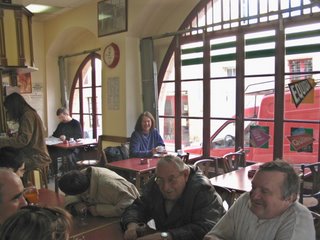 Coffee at Montpazier
Coffee at Montpazier The cake shop in the tithe barn, Montpazier
The cake shop in the tithe barn, MontpazierBy lunchtime the sun had climbed cheerfully out of bed and was even giving off a slight warmth as we sat on the square with our nutty cakes – a speciality of the region famed for its walnuts and chestnuts – watching the menfolk returning home for Sunday lunch after collecting their bread and cakes from the boulanger. Generally though, it has remained icy cold but dry all day.
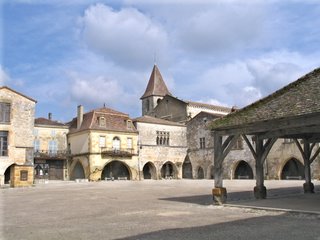 Deserted market square at lunchtime, Montpazier
Deserted market square at lunchtime, Montpazier Covered market with measures for nuts at Montpazier
Covered market with measures for nuts at Montpazier Bringing home the baguette at Montpazier
Bringing home the baguette at Montpazier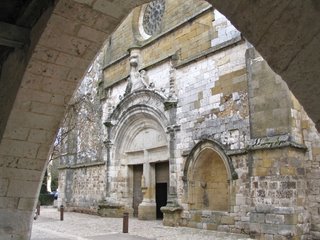 West entrance to the church at Montpazier
West entrance to the church at Montpazier Arcades across the grid pattern of streets at Montpazier
Arcades across the grid pattern of streets at MontpazierOur way continued through a pretty countryside with many fishing lakes and woodlands of beech and oak trees, their trunks covered in ivy – such a contrast to the cactuses and palms we have been seeing over the past few weeks! Frequently we would pass châteaux with their pointed slate-tiled towers, so quintessentially part of the French landscape, such as the one at Bannes.
 Chateau de Bannes near Lalinde
Chateau de Bannes near LalindeOur next stop was at Lalinde on the banks of the Dordogne. This too was a pretty little town – indeed every town is so crowded with historical and architectural delights it is impossible to think of an original way to describe them. Each has its individual charm but most are similar in building materials, age and architecture design being laid out on a grid system with a large central square and an imposing church-front close by.
 Market house at Lalinde
Market house at LalindeFrom Lalinde our route crossed the swollen brown Dordogne and continued to the hamlet of Badefols where we turned off along a tiny lane twisting up through fields and woodland to the even tinier hamlet of Viralet where we easily recognised the next point on our itinerary from the photo with a message on the back to the French friends of Pam and John.
 Bridge over the Dordogne at Lalinde
Bridge over the Dordogne at LalindeGerard and Any answered the door and although they knew absolutely nothing about us and had no idea we would be calling, as soon they realised we had mutual friends they welcomed us into their home with eager delight, longing for news of the English friends they were no longer able to see in person! We sat chatting in their lounge over glasses of peach juice and they gave us so many ideas of local places we simply had to visit it would take us weeks to see them all! Meanwhile we took photos of them and their daughters as a reminder to our Cornish friends and proof that we really did visit!
For us it was a delightful experience to be invited into the home of such friendly people and really start to use French again. Since we have been travelling and away from all our French friends there has been so little opportunity to really talk with anyone. For them, an unexpected message from their friends brought them obvious joy.
 Gerard and Any’s house
Gerard and Any’s houseNot wishing to outstay our welcome we left and continued to the pretty village of Molières, yet another tiny bastide town, where a book fair was taking place with more than 1,000 local titles on sale. We spent a delightful half hour here in the warm and bought a small book on local gardens as a birthday present and reminder for Pam.
 Jill chooses a book, Molières
Jill chooses a book, Molières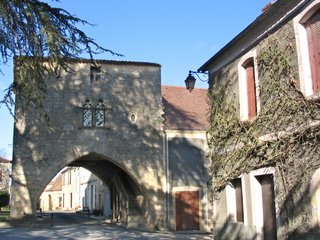 Molières
MolièresThe surrounding area is rich in Neolithic sites, most closed at present. Nearby are the Lascaux caves with their famous wall paintings of bison and deer. Like Altamira in Cantabria though, the original caves are closed to the public who are presented only with a fibreglass replica. We have decided once is enough. Some caves though do still allow access to the original paintings so we may search one out tomorrow.
The next postcard on our pile sent us to Cadouin abbey with its holy shroud, conveniently discovered in the early 13th century just after a period of crisis within the abbey. It was later removed to Toulouse, Paris and various other locations but is now back at Cadouin. However, like the abbey precinct, the shroud is being restored, so could not be viewed.
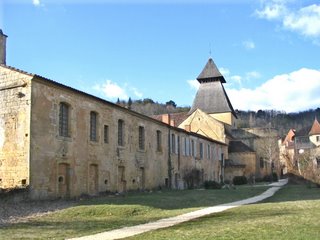 Abbey buildings, Cadouin
Abbey buildings, Cadouin The Abbey about to be restored, Cadouin
The Abbey about to be restored, CadouinThe town was a complete mess with every narrow street being dug up for cabling, bulldozers blocking crossroads, all traffic diverted around the town, scaffolding across the Cathedral entrance and the Mairie, and general mayhem – except that as it was Sunday nothing was actually being done. We did not see it at its best but are satisfied that it is indeed normally a picturesque town with an interesting abbey and cloisters.
The nearest open campsite we could discover was some distance away at Vézac near the banks of the Dordogne and within sight of Beynac et Cazenac, listed as yet another of France’s prettiest villages, with the castle dramatically perched on cliffs above the Dordogne. The campsite is run by a Dutch lady and tonight we are the only people here.
Monday 6th March 2006, Le Chalard, Limousin
We woke to find Modestine covered in ice and once again she snorted and spluttered before her engine eventually started. Once going however, she has been fine all day. We tried to find a Citroën garage to see whether there is anything to be done as it is very worrying not knowing in the evening if we will be able to get moving next morning. However, Monday is not a day for getting anything done in France and all the garages we found were closed.
We returned to look at the picturesque villages of Beynac et Cazenac that we passed through last night. Parking on the river bank we climbed up the steep, narrow streets between tiny stone cottages and several caves worn into the sandstone cliff. Built in warm golden sandstone that gives off a sunny glow even when the weather is icy cold, the twin villages nestle, one above the other, clinging to the steep-sided cliff face beneath which today the Dordogne was flowing fast and turbulent. On the very top of the cliff stands an impressive mediaeval castle with strong defensive walls and a wooden palisade. The views from here across the beautiful winter countryside are stunning.
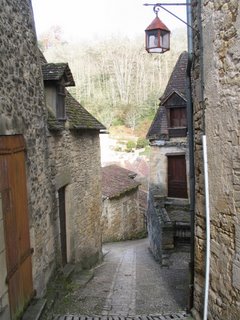 A street in Beynac et Cazenac, Dordogne
A street in Beynac et Cazenac, Dordogne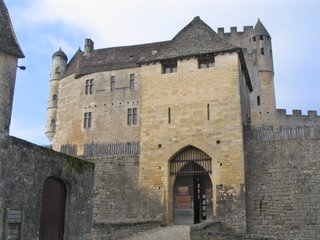 Castle at Beynac et Cazenac, Dordogne
Castle at Beynac et Cazenac, Dordogne Winter countryside showing the Château de Fayrac, seen from Beynac et Cazenac, Dordogne
Winter countryside showing the Château de Fayrac, seen from Beynac et Cazenac, Dordogne Castle in its setting, Beynac et Cazenac, Dordogne
Castle in its setting, Beynac et Cazenac, DordogneWe continued along the banks of the Dordogne to the famous Roque Gageac and Domme, two more on the list of France’s most beautiful villages, and with good justification. La Roque Gageac was similar to Beynac et Cazenac being built of golden sandstone above the banks of the Dordogne beneath a towering cliff of similar stone, riddled with caves where over the years dwellings had been fashioned-out. Again steep paths and steps lead up from the river to the vertiginously exposed church, chateau and tiny cottages clinging to the sides of the rock. Around the church is an exotic garden of Mediterranean palms and bamboo plants full of tiny singing birds. Perhaps the most curious feature of the village though was the troglodytic fort, a whole series of cave dwellings high up the cliff face reached by steps cut into the cliff and by ladders.
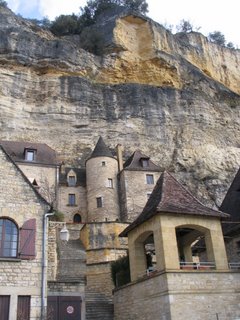 La Roque Gageac, Dordogne
La Roque Gageac, Dordogne La Roque Gageac on the edge of the Dordogne
La Roque Gageac on the edge of the Dordogne Troglodyte dwellings, La Roque Gageac, Dordogne
Troglodyte dwellings, La Roque Gageac, DordogneDomme was on the list of sites we had been asked to visit by our Cornish friends Pam and John. It is reached by a steep road and is perched high on a headland with a panoramic view over the river and the surrounding countryside. The village is another bastide of beautiful stone buildings in picturesque streets leading off a main square at right angles. For a mediaeval town we were surprised how wide the streets are.
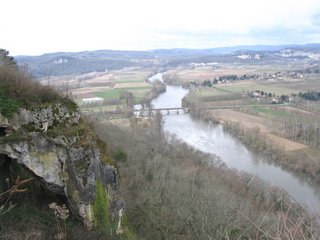 Valley of the Dordogne from Domme
Valley of the Dordogne from Domme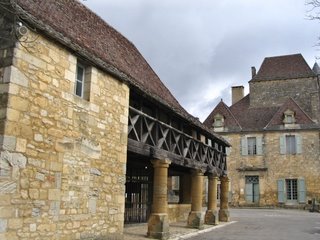 In the central square, Domme
In the central square, DommeNext we took on the challenge set by Pam and John of seeking out some ancient, primitive houses hidden deep in the countryside some 15 kilometres from the place they were reputed to be! They didn’t think we’d find them and they were nearly right! Leaving Modestine in a farmyard when the road ran out, we walked the last couple of kilometres along a broken tarmac’d track and were on the point of giving up when we discovered them. With no documentation however, we still know nothing about them.
 Cabanes du Breuil, near Sarlat, Dordogne
Cabanes du Breuil, near Sarlat, DordogneBefore seriously heading north we were determined to make up for the disappointment of our visit to the caves at Altamira where we saw only a facsimile of the cave and reproductions of the wall paintings. Near here are the famous Lascaux caves which, together with the Altamira cave paintings, enabled archaeologists to recognise that the paintings really were the work of early cave dwellers about 15,000 years ago. As in Spain, the cave has been closed to the public to preserve the paintings and only a facsimile can be seen. Along the Vézère valley however are many similar caves dating from the same period and open to the public. A very few have wall paintings. We were fortunate to stumble across the only one still open to the public with polychrome wall paintings – Font-de-Gaume. Numbers allowed in each day are strictly limited to ensure a balanced microclimate, but being winter there were very few people around. We were amazed to find it open and joined five other people and a very enthusiastic, highly knowledgeable guide for one of the most stunning and exciting visits we have ever made to an historic site!
 Entrance to the caves at Font-de-Gaume, Dordogne
Entrance to the caves at Font-de-Gaume, DordogneDeep inside the surprisingly warm cave – much warmer than outside – surrounded by stalagmites, side caves, tunnels, columns and curious rock formations, we saw on the cave wall a row of three or four bison painted in tones of red, orange, brown and black. They were wonderfully clear in the dim torchlight and painted in a manner that made maximum used of the natural features of the rock, blending art with nature. It is not easy to describe the sense of awed excitement inspired by seeing original art work thousands of years old in its intended setting. These wonderfully executed visual images reached out across time, linking us directly back to our early ancestors. In addition the caves held many other wall paintings of horses, reindeer and aurochs with the occasional mammoth. This cave though specialised in bison. Our guide was excellent, explaining that similarly dated painting in caves across Europe all represented similar animals and very little else. Plants or other animals are not depicted but it is not known why, or indeed, why the paintings were ever done, deep in the dark recesses of these caves using only a primitive smoking lamp for illumination. Sometimes geometric patterns can be found – they may be a counting system or calendar, and there was a single example of a human hand having rested on the rock face while coloured pigment was blown over it using a hollow bone from a bird, - rather like an aerosol - leaving the handprint silhouetted on the rock.
We emerged from the darkness of the cave into the bright sunlight and made our way back down the steep path to the road, deep in thought. Such an experience was everything that Altamira was not! We do have to recognise though that preservation is necessary and that we are very privileged to still have the possibility of seeing original prehistoric paintings. It is doubtful whether the caves will be admitting the public for much longer.
Our route continued through a beautiful countryside with wide vistas of woodland and open fields, lakes, chateaux, rivers, cliffs, caves and troglodyte dwellings. We are now just south of Limoges, famous for its finely hand-painted porcelain. One of the daughters of Gerard and Any whom we met yesterday works as a porcelain artist at Limoges but she says the company is closing down as there is no longer a demand for the product. This campsite is owned by an English couple who set it up sixteen years ago. As usual we are the only people staying here and it is pitch black outside with an icy wind. We expect trouble from Modestine tomorrow.
Tuesday 7th March 2006, Châteauponsac, Limousin
Modestine behaved exactly as we had anticipated. During the night temperatures dropped even lower and we woke to a white world of frost and freezing fog. The sun leered scornfully at us for a couple of seconds through its grubby duvet of grey clouds before turning over, putting its head under the pillow and pulling the thick covers up around it, deciding it was far too cold to get up today and anyway it was going to rain so why bother. Well, thought Modestine, if the sun can avoid getting up all day, why should I bother? So despite the extra covers we’d given her last night and the two hot water bottles tucked under her bonnet at breakfast time, she simply snorted and coughed, consistently refusing to get up and face the day. Realising eventually that Jill would probably choke her – literally - if she didn’t get going, she finally agreed to splutter her way to the nearby town and the Citroën garage. Here she was examined and declared to have a double appendicitis! Two of her plugs (or whatever they are with diesel engines) were covered in filthy soot and corroded in! They have now been replaced and she appears to be happier as she gallops along the waterlogged roads of the Limousin region. We won’t know for certain if she has been cured until we try to move on tomorrow morning.
During the day the ice slowly melted, as did the snow gathered by the roadside and in sheltered hollows. By lunchtime it was raining continuously from a leaden sky
Today we made our way to Oradour sur Glane which has gone down in history as the site of a Nazi massacre on 10th June 1944 when 637 people living in this little rural community were rounded up and killed, their village being completely destroyed. Situated in the Free French zone Oradour was selected, amongst other reasons, as an easy target which could be surrounded, the inhabitants forced into the village square and murdered with very little risk of casualties to the Nazi persecutors. The excuse for the massacre was that local Resistance fighters had been operating around Oradour and the Nazis were suffering substantial casualties. Nobody was spared in the Nazi raid, the men being separated from the women and shot in a number of locations around the town. Meanwhile the women and children were herded into the church where they were all burned to death. The final act of brutality by the Nazis was to then destroy the evidence by burying the charred corpses in a mass grave so nobody could be identified, thus denying their relatives the chance to lay them to rest and mourn them properly. Perhaps it is one of the reasons the memory of the horror lives on in this little town where the burned out walls of the church and houses act as a constant memorial to the victims.
 Burned-out remains of the church at Oradour’s Village Martyr, Limousin
Burned-out remains of the church at Oradour’s Village Martyr, Limousin Memorial stone on the walls of the church at Oradour’s Village Martyr, Limousin
Memorial stone on the walls of the church at Oradour’s Village Martyr, Limousin Interior of the church at Oradour’s Village Martyr, Limousin
Interior of the church at Oradour’s Village Martyr, LimousinHere in France they are referred to as martyrs for La France. It is perhaps not quite the right word. Martyrdom implies a degree of willingness on the part of the victim who has had the opportunity to recant but opted to suffer the persecution. Here there was no choice. The Nazis simply arrived at 2pm in the afternoon and herded everyone together – including the children from the village schools and babies in prams. Items found in the burned out rubble of the village are on display in the museum. They include children’s toys and metal tools and bottles contorted by the heat of the fire. In the church a twisted heap of metal at the base of the belfry shows how the heat melted the huge bell. Around the deserted streets the tramlines can still be seen and inside the ruined walls and roofless houses there are still the remains of metal objects - a pump, a sewing machine, a pram and even several rusting cars from the local garage.
 Main street preserved at Oradour’s Village Martyr, Limousin
Main street preserved at Oradour’s Village Martyr, Limousin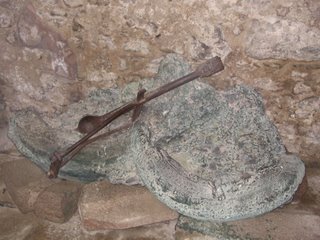 Melted remains of the church bell, Oradour’s Village Martyr, Limousin
Melted remains of the church bell, Oradour’s Village Martyr, Limousin Remains of cars in the village garage, Oradour’s Village Martyr, Limousin
Remains of cars in the village garage, Oradour’s Village Martyr, LimousinA new village was designed and built in the early 1950s by the authorities. Thus the town today stands beside the ruins of the former Oradour. The new town is a grim, grey place of indifferent architectural design, functional and very unattractive. It must be an unpleasant place to live today, part of a showpiece of history, permanently reminded of the horrors of the past.
 New church at the new Oradour, Limousin
New church at the new Oradour, LimousinIn 1953 the results of the Bordeaux anti-Nazi trials brought anger to the survivors and families of the victims when an amnesty was declared for the French Alsatians who had been forced into the German army and had been instrumental in carrying out the war crimes at Oradour. Because of their sense of having been betrayed the families of Oradour refused the mausoleum that had been built to hold the remains of the villagers, opting instead to build their own memorial in the churchyard. It is a moving experience to stand silently in the rain in front of this rather ugly monument with two glass urns holding the burned bones of the victims, the tricolour hanging from the flagpole and marble plaques to every victim around the walls, remembered by their families.
 Memorial in the village cemetery, Oradour, Limousin
Memorial in the village cemetery, Oradour, Limousin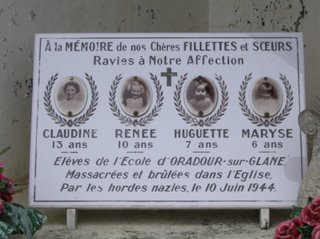 Just one of the hundreds of moving memorial plaques in the cemetery at Oradour, Limousin
Just one of the hundreds of moving memorial plaques in the cemetery at Oradour, LimousinMeanwhile, the state-built mausoleum has stood empty until the 1970s when it became a museum to the victims of Oradour and a beacon for peace. By defining the horrors of the Second World War, its causes, background and consequences there is always the hope that it will never be repeated. This afternoon there was a constant stream of young college students being guided around. They were remarkably quiet and attentive for groups of teenagers.
 Former mausoleum, now the museum at Oradour, Limousin
Former mausoleum, now the museum at Oradour, LimousinAfter our wonder yesterday at how advanced and civilised our early cave dwelling ancestors where, it was a sickening contrast today to recall just how uncivilized, evil and primitive mankind’s behaviour can be 15,000 years later. Just how far have human beings really advanced towards civilised enlightenment?
Our plans had not worked out as expected today and we had spent far longer at Oradour than we intended. In torrential rain and the half-light of early evening we did the only thing sensible and searched out the nearest open campsite for the night. Despite assurances from our directory, the first one at Bellac was closed. Twenty kilometres away we found this site open but deserted so have hooked up to the electricity and will pay for it tomorrow.
